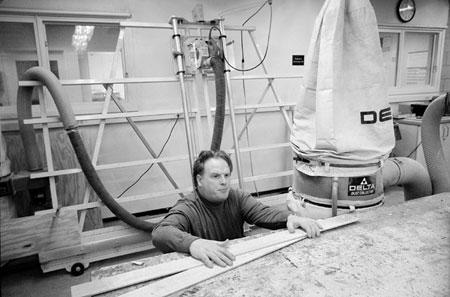The Big Picture
Adam Collier, Model maker

The way the word “model” is used in academic discourse can seem a bit of a letdown for those who grew up gluing together miniature aircraft carriers from boxes full of tiny plastic parts or stretching tissue paper over the balsa frameworks of World War I biplanes. Too often in academe models turn out to be something entirely abstract – numerical constructions that exist only in the electronic environment of a computer.
But for Adam Collier, models still retain all their satisfying three-dimensionality, their ability to enchant us by reducing something very large, like a building, to something small enough to hold in your hands or display on a tabletop. Collier, who earned a master’s of architecture degree from the Graduate School of Design (GSD) in 2000, is the school’s resident model-making guru. After spending the week working as an architect at D.W. Arthur & Associates in Boston, Collier spends Saturdays in the GSD’s model shop helping students realize their ideas.
Collier was making models long before he turned to architecture. Born in England, he went to art school at the University of London’s Goldsmith College and put in time building sets and props for local theater companies, then got a job at the British Museum helping to create models of historical villages for the Museum of Mankind. His experience also encompasses cabinet making, house carpentry, and fashioning mock-ups of new commercial products. He credits his wife with the decision to move to the States.
“She persuaded me I could do architecture, so I came here.”
After all his years of model-making experience, Collier is an expert at turning plans and drawings into free-standing objects. The process involves more than simply showing what the finished building will look like. It’s a design tool as well.
“Architects often have to turn out drawings very quickly and sometimes they don’t realize that what they’ve drawn doesn’t make sense. When you create a model, all those design problems immediately become apparent.”
Collier’s job brings him in contact with students of all skill levels, from experienced craftspeople to those who have never used tools before. He instructs them on using power tools safely and advises them on materials and construction methods, but one thing he never does is influence their designs.
“I regard that as personal,” he says. “It’s part of their process.”




